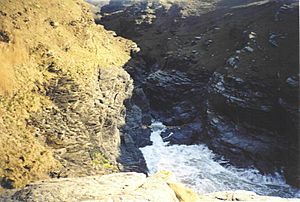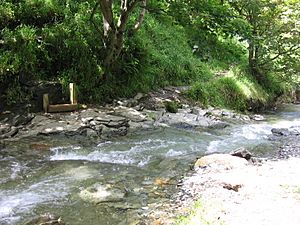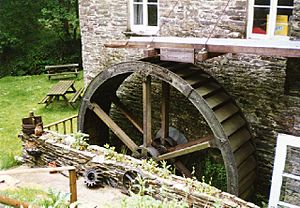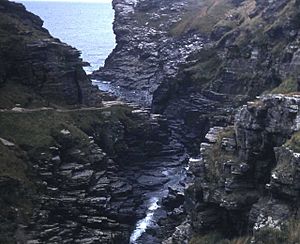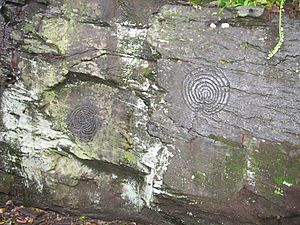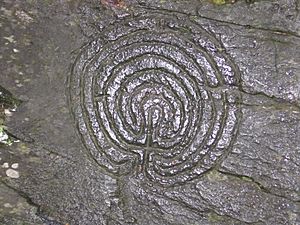Rocky Valley facts for kids
Rocky Valley is a beautiful, deep valley in north Cornwall, England. Its Cornish name is Glynn Duwy, which means 'deep valley of the river Duwy'.
This valley was carved out by the Trevillet River, also known as the Duwy or 'dark river'. The river flows through Trethevy, about one mile east of Tintagel. The valley walls are made of slate and can be over 70 feet tall!
People have written about Rocky Valley's amazing beauty since at least 1897. The National Trust now owns the valley. It is home to many different kinds of moss, with 161 species found here. A special woodland area called St Nectan's Glen stretches along the river. It's famous for a waterfall called St Nectan's Kieve.
The South West Coast Path goes into and out of the valley a little way from the sea. This is because the cliffs right on the coast are very steep. The rocks near the sea can be dangerous, and sometimes large waves have swept people off them.
In 2007, heavy rains caused flash floods in the valley. Some of the bridges over the Trevillet River were washed away. Luckily, new bridges have been built since then.
Exploring the Valley's Old Buildings
Rocky Valley has a history of mills that used the river's power.
The Old Mills of Trevillet River
There were three mills along the Trevillet River. These were Trethevy Mill, Trevillet Mill, and Halgabron Mill.
Trevillet Mill is now a private home. It became famous because of a painting by Thomas Creswick in 1851. The mill closest to the sea, Trethevy Mill, is now in ruins. In the 1700s, this mill was used to make woollen clothes.
You can find dates carved into the stone walls of the old Trethevy Mill. These carvings show when different people worked there or when parts of the mill were built. For example, 'W. T. 1779' is the oldest date found, likely from William Taylor. Other dates include 'D. R. 1794', 'T. B. 1797', and 'G. B. 1813'. The 1813 date marks when the mill was made bigger.
Mysterious Maze Carvings
In 1948, some interesting rock carvings were found in Rocky Valley. These carvings look like two circular mazes. Some people first thought they were from the early Bronze Age, which was around 1800 to 1400 BC.
However, experts now think these carvings are probably less than 300 years old. This is because they are carved on a wall that was cut out of the rock, and they seem to have been made with metal tools.
In 2005, someone claimed to see a third, very faint carving. This made some people wonder if the two clear carvings are copies of much older ones. But this idea has not been proven yet. The area around these carvings is seen as a special place by some people who follow certain spiritual beliefs.


